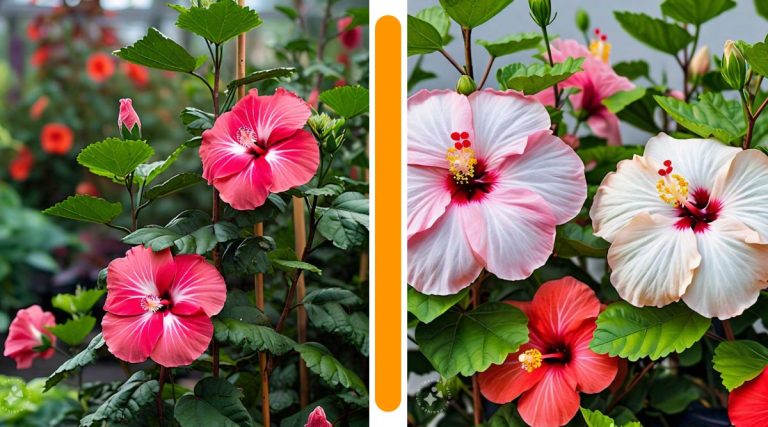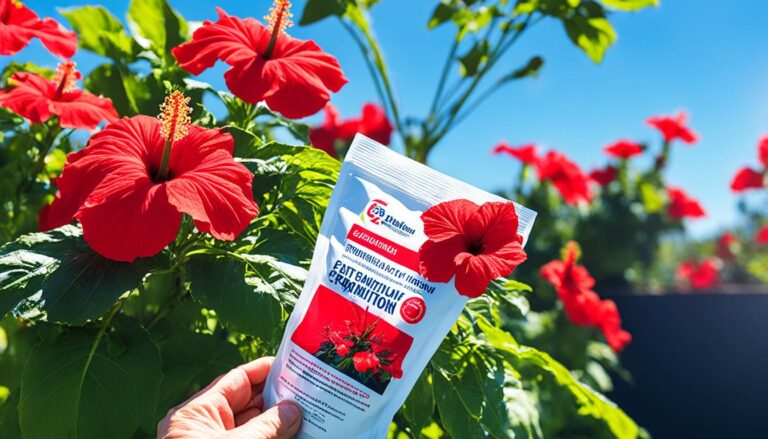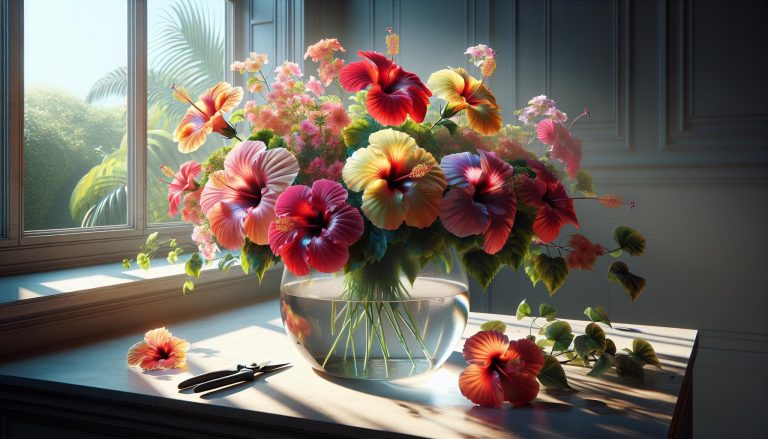Grow Vibrant Double Peach Hibiscus: Tips & Cultivation Secrets
In our quest for the perfect garden bloom, we’ve stumbled upon a gem that’s as luscious as it is lovely: the double peach hibiscus. This stunning flower is more than just a feast for the eyes; it’s a versatile plant that brings a touch of tropical elegance to any space. With its lush, layered petals and a warm, peachy hue, it’s no wonder this variety has captured the hearts of gardeners and floral enthusiasts alike.
We’re here to dive deep into the world of the double peach hibiscus, exploring its unique characteristics, care tips, and the undeniable charm it adds to gardens and homes. Whether you’re a seasoned gardener or just starting to green your thumb, you’ll find that this flower isn’t just a pretty face—it’s a resilient and radiant addition to your floral collection. Join us as we uncover the secrets to nurturing and enjoying the exquisite beauty of the double peach hibiscus.
Key Takeaways
- Historical and Cultural Significance: The double peach hibiscus is not just visually captivating; it also holds a deep historical and cultural significance rooted in Asia and the Pacific Islands. Renowned for its beauty and believed therapeutic properties, it has been a symbol of honor, love, and prosperity in various cultures.
- Unique Visual Appeal: This flower stands out with its lush, multi-layered petals and warm, peachy hues, ranging from soft peaches to vibrant corals. The distinctive color variations and the larger size of the blooms add a touch of tropical elegance to gardens and homes.
- Cultivation Tips for Optimal Growth: Key to thriving double peach hibiscus plants include well-draining, fertile soil with a slightly acidic to neutral pH, ample sunlight (at least six hours daily), and balanced watering practices. Proper care ensures a longer blooming period and more vibrant flowers.
- Versatile Uses and Health Benefits: Beyond its ornamental value, the double peach hibiscus serves culinary purposes, adding a tangy flavor to dishes and drinks, and possesses medicinal properties such as antioxidants for cardiovascular health and anti-inflammatory benefits.
- Companion Planting Enhancements: Pairing double peach hibiscus with compatible plants like lavender, marigolds, salvia, Shasta daisy, and Russian sage not only supports its growth but also elevates garden aesthetics with contrasting colors and textures.
- Pest and Disease Management: Employing preventive measures and treating pests or diseases promptly with eco-friendly solutions help maintain the health and beauty of double peach hibiscus plants.
Origin and Background
Historical Significance
Delving into the past, the double peach hibiscus embodies a rich history that intertwines cultural significance with botanical marvel. Initially discovered in Asia and the Pacific Islands, this flower has played a pivotal role not only in the botanical world but also in cultural ceremonies and traditional medicines. Historians and botanists suggest the cultivation of hibiscus, including the double peach variety, dates back centuries. Emperors and royal families often used the vibrant blooms in their gardens for their beauty and believed therapeutic properties. Moreover, various cultures integrated the flower into ceremonies, using it as a symbol for honor, love, and prosperity. This historical backdrop underlines the double peach hibiscus’s significance beyond its aesthetic appeal, highlighting its enduring presence in human history.
Geographic Distribution
The geographic journey of the double peach hibiscus spans continents, flourishing in both tropical and subtropical climates around the globe. Originally native to regions in East Asia, it has found a new home in many parts of the world, including the Americas, Africa, and parts of Europe, thriving in warm climates that mirror its native habitat. The adaptability of the double peach hibiscus to various soil types and climates contributes to its widespread cultivation. Gardeners and horticulturists in USDA zones 9 through 11, in particular, have successfully grown this variety, reveling in its lush, vibrant blooms that add a splash of tropical elegance to any setting. This broad geographic distribution not only showcases the plant’s versatile beauty but also its ability to connect different cultures through a shared appreciation of nature’s splendor.
Visual Characteristics
Following the introduction of the double peach hibiscus’s historical significance and geographic distribution, we now explore its stunning visual characteristics. The distinct appearance of this flower not only captivates gardeners and floral enthusiasts but also elevates any space it adorns.
The Double Blooms
The double peach hibiscus is renowned for its intricate, multi-layered blooms, distinguishing it from the more common single-layer varieties. Each flower showcases a remarkable depth, creating a lush, voluminous effect. These double blooms are a defining feature, making the plant a standout addition to gardens and indoor arrangements. Typically, the flowers can span up to 4-6 inches in diameter, embodying a luxurious presence. The double blooms also exhibit a longer blooming period, ensuring a vibrant display throughout the growing season, if proper care is administered.
Color Variations
Central to the allure of the double peach hibiscus is its unique color palette, ranging from soft peaches to vibrant coral tones. The petals often display a gradient effect, with the hues subtly shifting from the center outwards, giving each bloom its own distinctive appearance. In certain light, one might also notice delicate undertones of pink or yellow, adding to the complexity and beauty of the flower. This variation in color not only contributes to the visual impact of the double peach hibiscus but also lends itself to versatility in landscape designs or floral arrangements. Each plant can present a different shade, making every addition to a garden or home a personalized touch of nature’s artistry.
Cultivation Tips
Transitioning from the captivating history and visual allure of the double peach hibiscus, we now delve into essential cultivation tips to ensure these radiant blooms continue to grace gardens with their presence. With proper care and understanding of their needs, gardeners can encourage healthier growth and more vibrant flowers.
Ideal Soil Conditions
The foundation for thriving double peach hibiscus plants begins with the soil. They prefer well-draining, fertile soil rich in organic matter. A pH level ranging from slightly acidic to neutral, approximately 6.0 to 7.0, creates an optimal environment for nutrient absorption. To achieve these conditions, integrate compost or peat moss into the planting area. This amendment not only improves soil structure and drainage but also enriches the soil with essential nutrients, fostering a robust root system and flourishing plants.
Sunlight and Watering Needs
Light and water, crucial components of plant health, play significant roles in the cultivation of double peach hibiscus. Full sunlight, meaning at least six hours of direct exposure daily, is ideal for these flowers. This amount of sun encourages maximum blooming and ensures the vibrancy of their unique peach hues. In regions with particularly harsh afternoon sun, a location receiving partial shade can prevent overheating and dehydration.
Watering practices for double peach hibiscus require a balanced approach. The goal is to maintain evenly moist soil without waterlogging. During the growing season, watering once a week usually suffices, though the frequency may increase during hot, dry periods. Implementing a 2-3 inch layer of mulch around the base of the plant helps retain soil moisture and regulate soil temperature, reducing the need for frequent watering. Ensuring proper hydration while preventing the retention of excessive water is key to avoiding root rot and promoting a healthy plant.
By following these guidelines, gardeners can provide double peach hibiscus plants with the necessary care and conditions to thrive, leading to an impressive display of beauty and color in their outdoor spaces.
Uses and Benefits
Following our exploration into the stunning double peach hibiscus, including its history, significance, and cultivation tips, we now delve into the various uses and benefits that make this flower not just a visual delight but also a versatile addition to culinary and medicinal practices.
Culinary Applications
Our journey into the uses of double peach hibiscus reveals an unexpected yet fascinating culinary facet. The vibrant petals of this flower possess a slightly tangy flavor, making them a unique ingredient in a variety of dishes and beverages. Chefs and home cooks alike incorporate the petals into salads for a burst of color and a hint of zest. Moreover, the double peach hibiscus serves as an exquisite garnish on desserts, adding a touch of elegance and flavor complexity to cakes and pastries.
Beverages, particularly teas, benefit significantly from the infusion of double peach hibiscus petals, offering a refreshing and slightly tart taste that is both invigorating and soothing. These tea infusions not only delight the palate but also present a visual feast with their deep, rich colors. Creative mixologists have even started to experiment with these petals in cocktails, introducing innovative drinks that are as captivating in flavor as they are in appearance.
Medicinal Properties
Beyond the culinary realm, the double peach hibiscus holds remarkable medicinal properties that have been recognized and utilized in various cultures for centuries. The petals and leaves of the flower are known to contain antioxidants, which contribute to overall health by fighting off free radicals that cause oxidative stress and damages to cells.
One of the most celebrated health benefits of double peach hibiscus is its ability to support cardiovascular health. Regular consumption of tea made from its petals can contribute to lowering high blood pressure, a significant risk factor for heart diseases. This heart-healthy aspect is attributed to the flower’s bioactive compounds, which work to improve blood flow and reduce hypertension.
Another significant benefit includes its anti-inflammatory and antimicrobial properties, making it a valuable natural remedy for alleviating discomfort from minor inflammations and infections. Whether consumed as a tea or applied topically in oils and extracts, double peach hibiscus offers soothing relief and promotes healing.
The double peach hibiscus not only beautifies gardens and homes with its stunning flowers but also enriches our culinary experiences and supports health with its beneficial properties. Embracing this flower in our daily lives allows us to enjoy not only its visual appeal but also the myriad of advantages it brings to our well-being and culinary adventures.
Companion Plants
Enhancing Growth and Aesthetics
Selecting the right companion plants for double peach hibiscus involves understanding plant compatibility and the benefits of strategic pairings. We aim to enhance both the growth and aesthetics of our garden by choosing plants that share similar soil, sunlight, and watering needs while also providing complementary colors and textures.
- Lavender: This herb not only shares a preference for sunny locations and well-draining soil but also adds a delightful contrast with its silver foliage and purple flowers. Lavender’s scent can deter pests, benefiting the double peach hibiscus.
- Marigolds: Known for their pest-repelling properties, marigolds are excellent companions. Their bright orange and yellow blooms create a vibrant contrast, enhancing the visual appeal of the double peach hibiscus.
- Salvia: Offering a variety of colors, Salvia plants can match the double peach hibiscus for sun and soil requirements. Their vertical spikes of flowers add height and structure to the garden.
- Shasta Daisy: For gardeners seeking a cottage garden look, Shasta daisy offers white, cheerful blooms that complement the soft peach tones of the hibiscus flowers. Both plants thrive in full sun to partial shade and require moderate watering.
- Russian Sage: Its airy, lavender-blue flowers stand tall and provide a soft background that makes the vibrant blooms of the double peach hibiscus stand out. Russian sage also prefers full sun and well-draining soil.
These companions not only support the growth of double peach hibiscus by sharing similar cultural requirements but also elevate the garden’s aesthetic by providing a contrasting backdrop that highlights the hibiscus’s stunning flowers. Through thoughtful pairing, we ensure our hibiscus not only thrives but also plays a starring role in a beautifully composed garden tableau.
Handling Common Pests and Diseases
In the journey of nurturing the double peach hibiscus to its full splendor, it’s crucial to be vigilant about the common pests and diseases that can threaten its health. With our expertise, we guide you through effective strategies to protect these radiant flowers.
Preventive Measures
Preventive measures play a pivotal role in safeguarding the double peach hibiscus from pests and diseases. Ensuring a strong start, we recommend selecting disease-resistant varieties, as they offer an intrinsic shield against common ailments. It’s also beneficial to practice good sanitation by removing fallen leaves and debris, which often harbor pests and pathogens. Promoting excellent air circulation around plants by spacing them properly when planting helps minimize the risk of fungal infections, such as powdery mildew and rust. Additionally, maintaining a balanced moisture level in the soil through drip irrigation or soaker hoses can prevent root rot and discourage pests from settling in. Implementing companion planting with garlic or chives can naturally deter aphids and other pests, further enhancing the double peach hibiscus’ ability to thrive.
Treatment Options
Despite our best efforts, pests and diseases can sometimes breach our defenses. In such instances, identifying the problem early is key to effective treatment. For pests like aphids, whiteflies, and spider mites, a strong jet of water from a hose can dislodge them from the plant. If needed, insecticidal soap or neem oil can provide an eco-friendly solution to control these pests without harming beneficial insects. In the case of fungal diseases, removing affected leaves and applying a fungicide according to label instructions can help manage the spread. For severe infestations or persistent issues, consulting with a local cooperative extension service or plant nursery for specific advice may be beneficial. Our emphasis remains on using targeted treatments that preserve the health of the double peach hibiscus and the environment.
By diligently implementing these preventive strategies and being prepared with treatment options, we can ensure that the double peach hibiscus remains a vibrant and healthy addition to any garden or home setting.
Personal Experience and Recommendations
My Cultivation Journey
Embarking on our journey with double peach hibiscus, we’ve been captivated by its stunning blooms and rich history, which we’ve learned have roots in Asia and the Pacific Islands. Our experience began with planting a few in our garden, attracted by their resilience and the vibrant splash of color they promised. Over time, we discovered not just a plant that thrives with proper care, but one that adds unique beauty and a touch of elegance to our landscape. Following the essential cultivation tips, we focused on providing the ideal soil conditions, ensuring adequate sunlight exposure, and maintaining a consistent watering schedule. Our efforts were rewarded with healthier growth and more luminous flowers. Moreover, we’ve experimented with companion planting, integrating flowers like lavender and marigolds, which not only enhanced the garden’s aesthetics but also supported the hibiscus’s growth by attracting beneficial insects and deterring pests.
Tips for Beginners
For anyone looking to start their own journey with double peach hibiscus, here are our top recommendations based on our personal experience and extensive research. First, always select a planting location that receives plenty of sunlight, as this is crucial for the flower’s vibrant blooming. Secondly, pay close attention to the soil type; well-drained, fertile soil works best. Incorporate organic matter to enrich the soil before planting, ensuring your hibiscus has all the nutrients it needs to flourish. Don’t overlook the importance of regular, moderate watering, especially during the warmer months, to keep the soil evenly moist but not waterlogged. Additionally, regular pruning will not only keep your hibiscus healthy but will also encourage more blooms. Finally, be vigilant about pests and diseases. Early identification and eco-friendly solutions are key to keeping your plants healthy. By following these guidelines, beginners can grow a vibrant and thriving double peach hibiscus that enhances any garden or home.
Conclusion
Embracing the double peach hibiscus in our gardens has been a journey filled with vibrant blooms and rich history. We’ve learned the significance of proper care—from ensuring the right soil conditions to managing pests effectively. This flower isn’t just a feast for the eyes; it’s a plant with deep cultural roots and practical benefits. Whether you’re a seasoned gardener or a beginner, the double peach hibiscus offers a rewarding experience, adding a splash of color and a touch of the exotic to your outdoor space. Let’s continue to nurture these stunning blooms, ensuring they remain a cherished part of our gardens for years to come.






